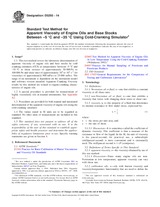Potřebujeme váš souhlas k využití jednotlivých dat, aby se vám mimo jiné mohly ukazovat informace týkající se vašich zájmů. Souhlas udělíte kliknutím na tlačítko „OK“.
ASTM D7303-12
Standard Test Method for Determination of Metals in Lubricating Greases by Inductively Coupled Plasma Atomic Emission Spectrometry
Automaticky přeložený název:
Standardní zkušební metoda pro stanovení kovů v maziva by indukčně vázanou plazmou atomovou emisní spektrometrii
NORMA vydána dne 1.6.2012
Informace o normě:
Označení normy: ASTM D7303-12
Poznámka: NEPLATNÁ
Datum vydání normy: 1.6.2012
Kód zboží: NS-38112
Počet stran: 7
Přibližná hmotnost: 21 g (0.05 liber)
Země: Americká technická norma
Kategorie: Technické normy ASTM
Kategorie - podobné normy:
Anotace textu normy ASTM D7303-12 :
Keywords:
additive elements, aluminum, antimony, barium, calcium, emission spectrometry, grease, ICP, inductively-coupled plasma emission spectrometry, internal standard, iron, lithium, lubricating grease, magnesium, molybdenum, phosphorus, silicon, sodium, sulfur, zinc, ICS Number Code 75.100 (Lubricants, industrial oils and related products)
Doplňující informace
| Significance and Use | ||||||||||||||||||||||||||||||||||||||||||||||||||||||||
|
Lubricating greases are used in almost all bearings used in any machinery. Lubricating grease is composed of ~90 % additized oil and soap or other thickening agent. There are over a dozen metallic elements present in greases, either blended as additives for performance enhancements or as thickeners, or in used greases present as contaminants and wear metals. Determining their concentrations can be an important aspect of grease manufacture. The metal content can also indicate the amount of thickeners in the grease. Additionally, a reliable analysis technique can also assist in the process of trouble shooting problems with new and used grease in the field. Although widely used in other sectors of the oil industry for metal analysis, ICP-AES based Test Methods D4951 or D5185 cannot be used for analyzing greases because of their insolubility in organic solvents used in these test methods. Hence, grease samples need to be brought into aqueous solution by acid decomposition before ICP-AES measurements. Test Method D3340 has been used to determine lithium and sodium content of lubricating greases using flame photometry. This technique is no longer widely used. This new test method provides a test method for multi-element analysis of grease samples. This is the first DO2 standard available for simultaneous multi-element analysis of lubricating greases. |
||||||||||||||||||||||||||||||||||||||||||||||||||||||||
| 1. Scope | ||||||||||||||||||||||||||||||||||||||||||||||||||||||||
|
1.1 This test method covers the determination of a number of metals such as aluminum, antimony, barium, calcium, iron, lithium, magnesium, molybdenum, phosphorus, silicon, sodium, sulfur, and zinc in unused lubricating greases by inductively coupled plasma atomic emission spectrometry (ICP-AES) technique. 1.1.1 The range of applicability for this test method, based on the interlaboratory study conducted in 2005, is aluminum (10–600), antimony (10–2300), barium (50–800), calcium (20–50 000), iron (10–360), lithium (300–3200), magnesium (30–10 000), molybdenum (50–22 000), phosphorus (50–2000), silicon (10–15 000), sodium (30–1500), sulfur (1600–28 000), and zinc (300–2200), all in mg/kg. Lower levels of elements may be determined by using larger sample weights, and higher levels of elements may be determined by using smaller amounts of sample or by using a larger dilution factor after sample dissolution. However, the test precision in such cases has not been determined, and may be different than the ones given in Table 1. 1.1.2 It may also be possible to determine additional metals such as bismuth, boron, cadmium, chromium, copper, lead, manganese, potassium, titanium, etc. by this technique. However, not enough data is available to specify the precision for these latter determinations. These metals may originate into greases through contamination or as additive elements. 1.1.3 During sample preparation, the grease samples are decomposed with a variety of acid mixture(s). It is beyond the scope of this test method to specify appropriate acid mixtures for all possible combination of metals present in the sample. But if the ash dissolution results in any visible insoluble material, the test method may not be applicable for the type of grease being analyzed, assuming the insoluble material contains some of the analytes of interest. 1.2 Elements present at concentrations above the upper limit of the calibration curves can be determined with additional appropriate dilutions of dissolved samples and with no degradation of precision. 1.3 The values stated in SI units are to be regarded as the standard. The values given in parentheses are for information only. 1.4 This standard does not purport to address all of the safety concerns, if any, associated with its use. It is the responsibility of the user of this standard to establish appropriate safety and health practices and determine the applicability of regulatory limitations prior to use. Specific warning statements are given in Sections 8 and 10. TABLE 1 Precision of Grease Analysis Note—X is the mean concentration in mg/kg.
|
||||||||||||||||||||||||||||||||||||||||||||||||||||||||
| 2. Referenced Documents | ||||||||||||||||||||||||||||||||||||||||||||||||||||||||
|
Podobné normy:
Historická
1.1.2014
Historická
1.5.2011
Historická
15.9.2013
Historická
1.5.2010
Historická
1.5.2014
Historická
1.5.2013



 ASTM D5182-97(2014)..
ASTM D5182-97(2014).. ASTM D5183-05(2011)..
ASTM D5183-05(2011).. ASTM D5185-13e1
ASTM D5185-13e1 ASTM D5291-10
ASTM D5291-10 ASTM D5293-14
ASTM D5293-14 ASTM D5306-92(2013)..
ASTM D5306-92(2013)..
 Cookies
Cookies
